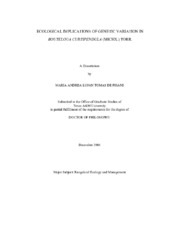| dc.contributor.advisor | Archer, Steve | |
| dc.creator | Andrea, Tomas de Pisani, Maria | |
| dc.date.accessioned | 2005-02-17T21:00:17Z | |
| dc.date.available | 2005-02-17T21:00:17Z | |
| dc.date.created | 2004-12 | |
| dc.date.issued | 2005-02-17 | |
| dc.identifier.uri | https://hdl.handle.net/1969.1/1394 | |
| dc.description.abstract | The two most common varieties of the grass Bouteloua curtipendula (Michx.)Torr. in North America use different strategies of clonal growth and have contrasting continental distributions. Variety caespitosa (phalanx form) ranges from central Texas westward to Arizona and California and var. curtipendula (guerrilla form) occurs in a more mesic region over the North American Great Plains. This study sought to determine whether the strategies had an ecological significance and investigated the possible relationship between changes in environmental factors and characteristics of each clonal growth strategy.
Varieties showed to be morphologically variable, but the variability did not follow the pattern of the precipitational gradient. The abundance of var. curtipendula was related to soil depth and parent material (limestone types). Abundance of var. caespitosa could not be explained by any environmental factor separately. The performance of clones of the two growth forms in response to changes in resource availability (light and nutrients) and defoliation suggested similarities between the varieties in photosynthetic rate and only showed differences in water potential under extreme conditions. The major differences were related to the proportion of biomass allocated to structures related with seed production versus propagation by rhizomes. Intra-variety genetic variation for several life history traits was detected even with a very small sample size. The caespitose growth form showed more biomass and rate of tiller recruitment after defoliation on average, but responses between genotypes were dissimilar. Varieties also showed levels of plasticity in the allocation to reproductive structures in response to environmental factors.
Responses to fire were compared between varieties by experimental burnings with increasing load of artificial fuel. Plants of the two varieties reached similar maximum temperatures although var. caespitosa suffered temperatures considered to be lethal for longer periods of time. Results from this study suggested that, although characteristic of the pattern of clonal growth were not distinctly associated to resource availability or defoliation, distribution of the varieties may be related to a combination of biotic and abiotic factors beyond the factors studied here. | en |
| dc.format.extent | 3754033 bytes | en |
| dc.format.medium | electronic | en |
| dc.format.mimetype | application/pdf | |
| dc.language.iso | en_US | |
| dc.publisher | Texas A&M University | |
| dc.subject | genetic variation | en |
| dc.subject | ecophysiology | en |
| dc.subject | defoliation | en |
| dc.subject | response to fire | en |
| dc.subject | light and nutrients availability | en |
| dc.subject | clonal growth | en |
| dc.subject | c4 grass | en |
| dc.subject | varieties | en |
| dc.title | Ecological significance of the genetic variation in Bouteloua curtipendula (Michx.)Torr. | en |
| dc.type | Book | en |
| dc.type | Thesis | en |
| thesis.degree.department | Rangeland Ecology and Management | en |
| thesis.degree.discipline | Rangeland Ecology and Management | en |
| thesis.degree.grantor | Texas A&M University | en |
| thesis.degree.name | Doctor of Philosophy | en |
| thesis.degree.level | Doctoral | en |
| dc.contributor.committeeMember | Taylor, Charles, Jr. | |
| dc.contributor.committeeMember | Gelwick, Frances | |
| dc.contributor.committeeMember | Hatch, Stephan | |
| dc.type.genre | Electronic Dissertation | en |
| dc.type.material | text | en |
| dc.format.digitalOrigin | born digital | en |


